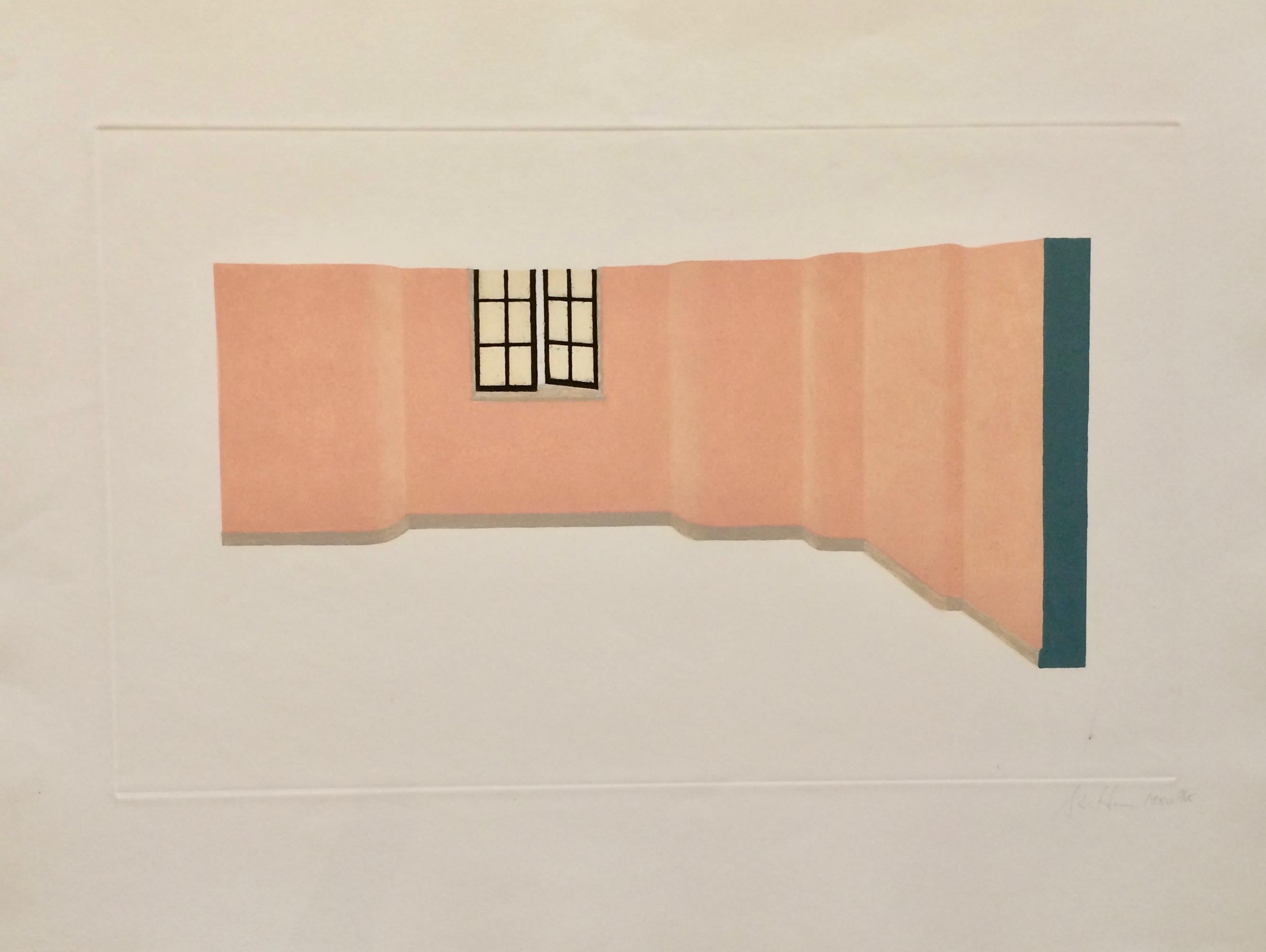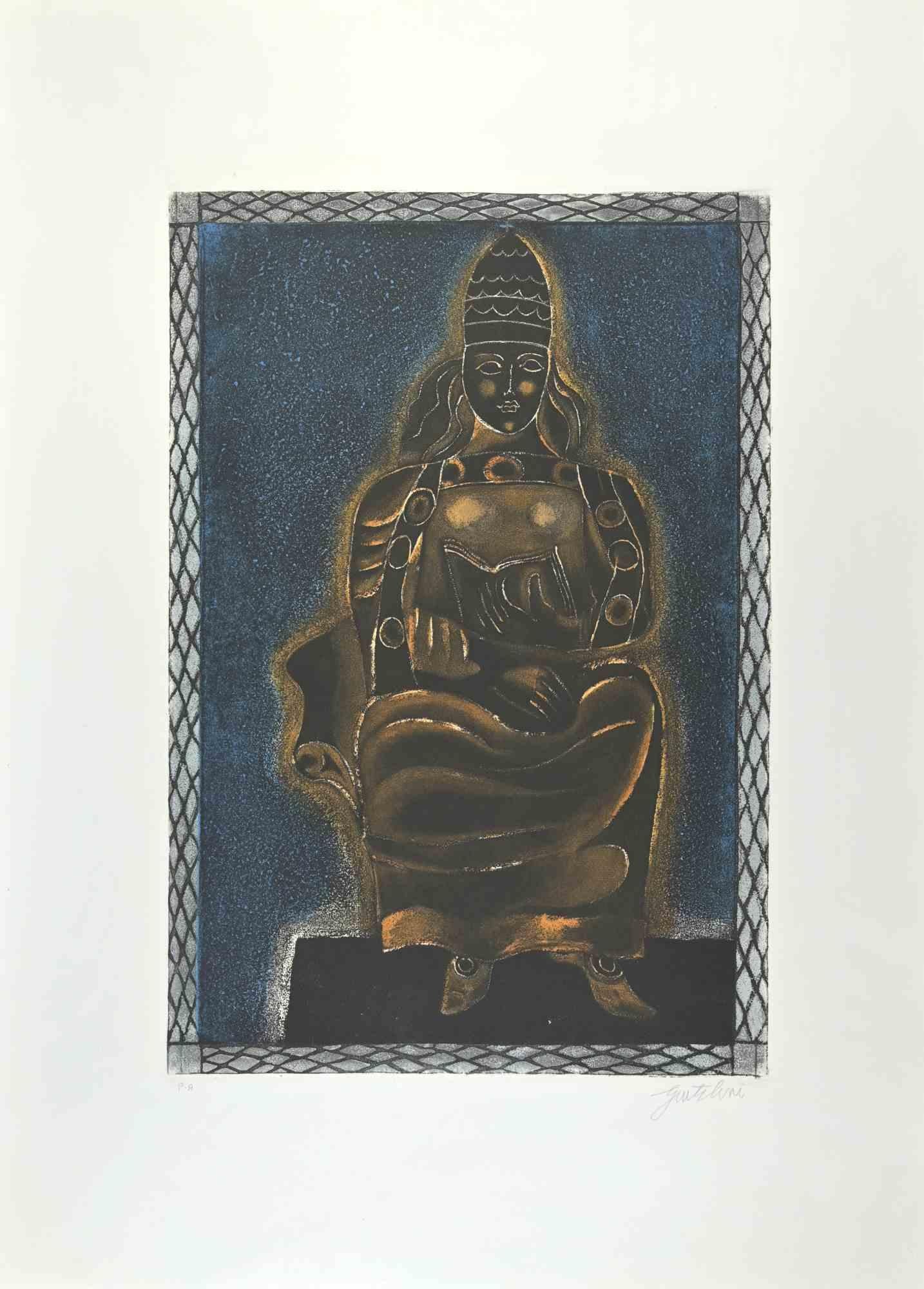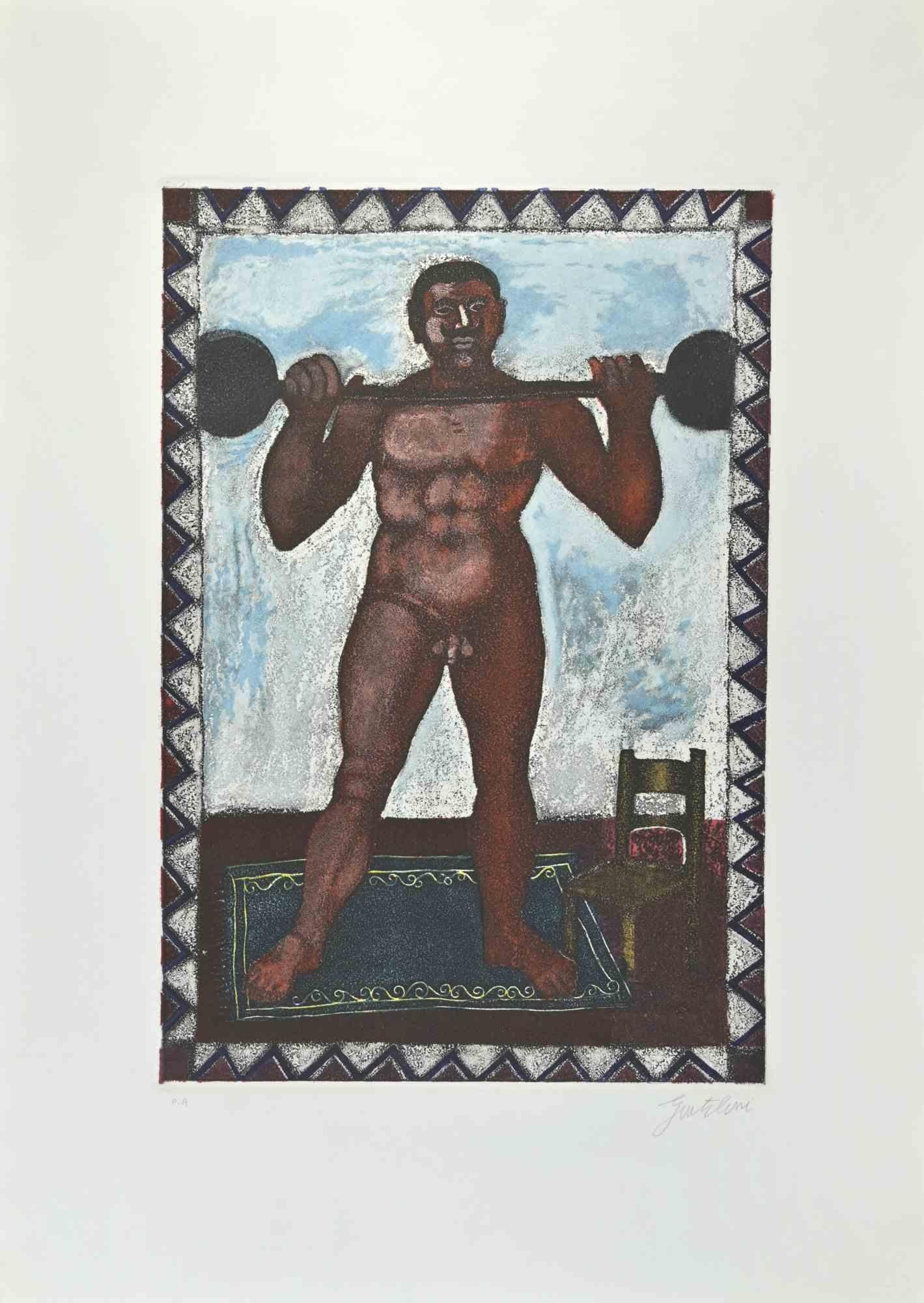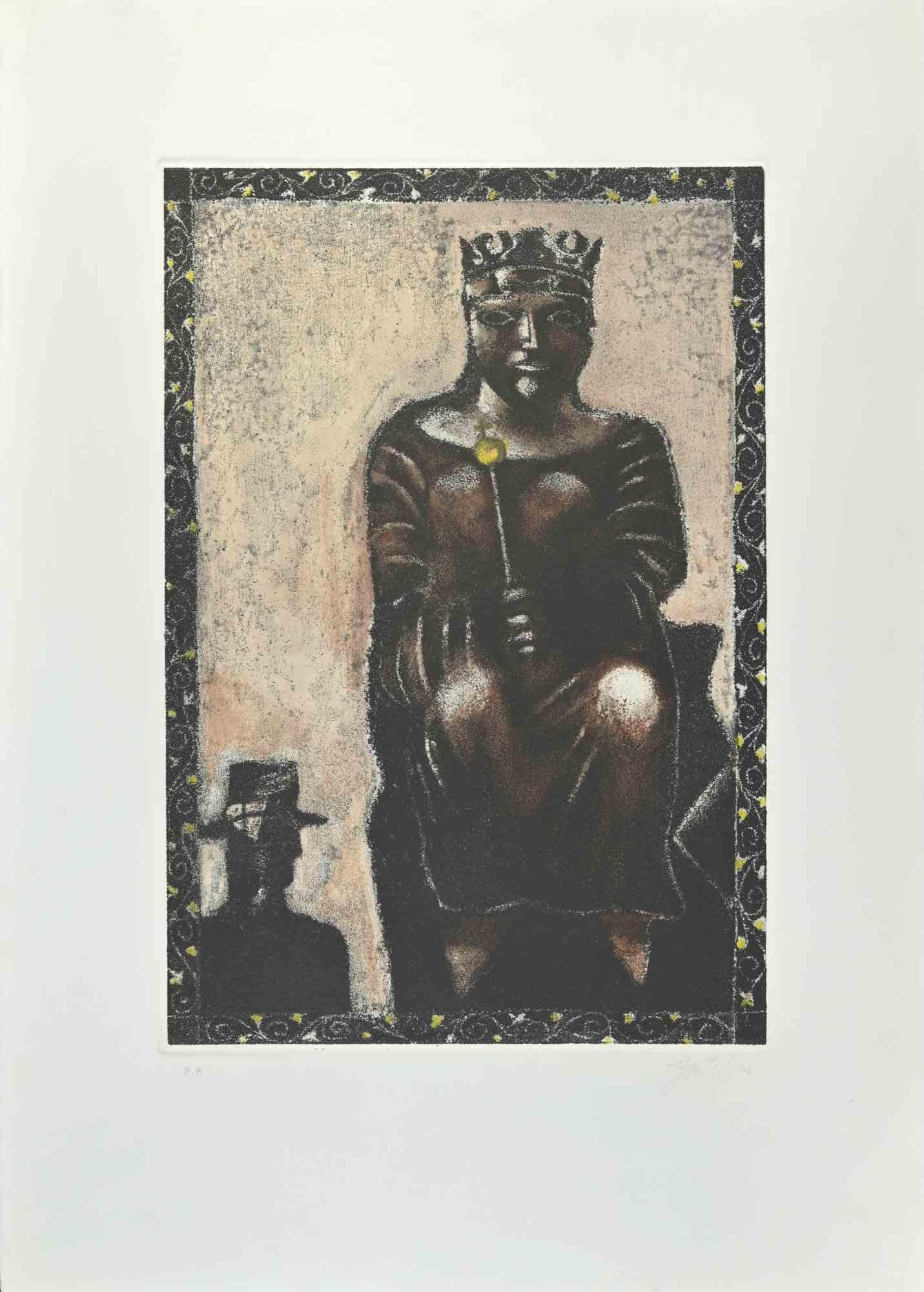Items Similar to The MoMA Library
Want more images or videos?
Request additional images or videos from the seller
1 of 8
Xiaoze XieThe MoMA Library2006
2006
About the Item
This piece is part of an ongoing project entitled "Fragmentary Views" (2001 - Present) by Xiaoze Xie, which is a series of paint-compositions based upon photographs of found newspaper piles. For Xie, stacks of printed pages represent not only cultural memory and the passage of time, but the ways in which history is interpreted and recorded according to various belief systems and political agendas. This is a lithograph, signed, dated 2006, and numbered 28/30
The artist continues his ongoing series of works, Fragmentary Views (2001 to present), which explores the vulnerability and fragmentary nature of historical memory, and the general and superficial perception of world events in the age of ready global media. The paintings depict stacked newspapers where only bits of information are visible-a greater understanding is implicit, but just out of view.
"What interests me most is the temporary nature of this mundane object loaded with all-encompassing information of changing daily life: from the front-page news to stock market columns to birth announcements and obituaries. Newspapers are recycled. Life goes on." - Xiaoze Xie
In the compressed stacks of newspapers, viewers will notice partial images of fragile life in Baghdad, distraught looks of disbelief of suicide attack victims, the building site of the World Trade Center, campaigns against Fa Lung Gong, and, more recent events that are closer to home. The gravity of these events is muffled as it is embedded in the mundane scroll of daily life.
Xiaoze Xie immigrated from the People's Republic of China in 1992, where he was born and studied art and architecture. He has MFA degrees from Beijing and North Texas University, and taught at Bucknell University before assuming his post as Professor of Art at Stanford.
His works are in the collections of the Museum of Fine Arts, Houston, the Scottsdale Museum of Contemporary Art and distinguished private collections.
Solo Exhibitions
Scottsdale Museum of Contemporary Art, AZ
Dallas Visual Art Center, TX
Modern Chinese Art Foundation, Gent, Belgium
Charles Cowles Gallery, New York
Gallery Paule Anglim, San Francisco
Nicholas Metivier Gallery, Toronto
China Art Archives and Warehouse, Beijing
Gaain Gallery, Seoul
Devin Borden Hiram Butler Gallery, Houston, TX
He has participated in numerous group exhibitions including Shu: Reinventing Books in Contemporary Chinese Art at the China Institute Gallery in New York and Seattle Asian Art Museum, and the traveling exhibition Regeneration: Contemporary Chinese Art from China and the US. His 2004 solo at Charles Cowles was reviewed in “The New York Times”, “Art in America” and "Art Asia Pacific". More recent shows have been reviewed in “Chicago Tribune”, “The Globe and Mail” and “San Francisco Chronicle”.
His work is in the permanent collection of the Museum of Fine Arts, Houston and the Scottsdale Museum of Contemporary Art and the Arizona State University Art Museum. Xie received the Pollock-Krasner Foundation Grant (2003) and artist awards from Phoenix Art Museum (1999) and Dallas Museum of Art (1996).
Xie is the Paul L. & Phyllis Wattis Professor of Art at Stanford University.
- Creator:Xiaoze Xie (1966, Chinese)
- Creation Year:2006
- Dimensions:Height: 22 in (55.88 cm)Width: 27 in (68.58 cm)
- Medium:
- Movement & Style:
- Period:
- Condition:
- Gallery Location:Surfside, FL
- Reference Number:1stDibs: LU38210796032
About the Seller
4.9
Platinum Seller
These expertly vetted sellers are 1stDibs' most experienced sellers and are rated highest by our customers.
Established in 1995
1stDibs seller since 2014
1,548 sales on 1stDibs
Typical response time: 1 hour
- ShippingRetrieving quote...Ships From: Surfside, FL
- Return PolicyA return for this item may be initiated within 3 days of delivery.
More From This SellerView All
- American Modernist "Feast of Pure Reason" Aquatint Mezzotint Etching WPA ArtistBy Jack LevineLocated in Surfside, FLJack Levine, American, 1915–2010 The Feast of Pure Reason, 1970 Etching, mezzotint and aquatint on copper in black ink. 20 w. 25 in., sight overall: 27 x 31.75 in., matted. Depict...Category
1970s Expressionist Figurative Prints
MaterialsMezzotint, Etching, Aquatint
- Jane Goldman Contemporary Floral Luminous Color Etching Flowers Chinese GeishasLocated in Surfside, FLHand signed and dated intaglio etching in color. 1982 Corner Reflections #2 Jane E. Goldman was born in Dallas, Texas in 1951 and received her Bachelor of Arts degree from Smith College and a Master of Fine Arts from the University of Wisconsin. She is known for her high color floral and nature design painting, printmaking and teaching. Goldman's media include watercolor, oil painting, silkscreen, intaglio print, lithograph, relief, screenprint,. aquatint etching and terrazzo. "Lyrical realism," based on a combination of free association and direct observation, best describes her style. Goldman’s luminous prints reveals the artist’s muse in a graphically novel way. Her work pays homage to 19th-century naturalist and artist John James Audubon. Goldman’s sun-dappled still life compositions, sprays of cut flowers in glass vases and lush flora growing in natural environments frame each setting and cast shadows across opened books that display images from Audubon’s Birds of America. Jane Goldman dance of light and dark patterns over table cloths, floor tiles and interior views dazzle with their use of color and composition. Goldman is the co-owner/director of Mixit Print Studio in Somerville, Massachusetts. A nationally recognized painter and printmaker, she has taught at Massachusetts College of Art, the University of California at Los Angeles, Rice University in Houston, and the University of Hartford. She has been a visiting artist at many institutions, including Harvard University, the University of Wisconsin, Smith College, Wellesley College, and the University of Dallas. Since 1975, Goldman’s work has been exhibited widely in the United States and abroad. She has received grants from the Massachusetts Council on the Arts, MacDowell Colony, Yaddo, and the Virginia Center for the Creative Arts. She has also received residency fellowships from the Ballinglen Arts Foundation in Ireland, the Oberpfälzer Künstlerhaus in Germany, and the Cite des Arts in Paris. Along with Janet Fish, Richard Bosman, Gladys Nilsson, Mary Lee Bendolph, Marylyn Dintenfass, Sidney Hurwitz, Hunt Slonem, April Gornik, Karsten Creightney, Stanley Casselman...Category
1980s Contemporary Interior Prints
MaterialsColor, Etching
- Judaica Jewish Shtetl Etching Yeshiva Talmudic Study Vintage Chassidic Art PrintBy Paul JeffayLocated in Surfside, FL"Qui a raison?" Chassidic boy, Yeshiva student with open book. Judaica, Jewish scenes from a ghetto. Saul Yaffie, a.k.a. Paul Jeffay, (1898–1957) was a Scottish Jewish artist. Known for his charming French street scenes as well as his judaica work. This is signed in the plate and dated 1931 in the print. This is done in a style similar to the works of the early Bezalel School artists Hermann Struck and Jakob Steinhardt. This lithograph, by artist Paul Jeffay depicts a Judaic Shtetl interior scene with great charm and sensitivity. Saul Yaffie was born in Blythswood, Glasgow on 29 April 1898. His mother was Kate Yaffie (née Karkonoski), and his father, Bernard Yaffie, was a master tailor. Like many Russian Jews, Kate and Bernard Yaffie fled persecution in Russia during a wave of anti-Jewish pogroms triggered by the assassination of Tsar Alexander II in 1881. Saul's father was naturalised as a British citizen by the time that Saul himself was three; a Bernard Yaffie is recorded as living at Abbotsford Place in the old Gorbals, where the young Saul spent the early years of his childhood. The Yaffies were not unique in their situation: the Gorbals was the centre of Scotland's Jewish community and home to a large proportion of Glasgow's immigrants throughout the early 20th century. Over time, there was a movement to some of the more affluent communities in Glasgow, such as Pollokshields and Garnethill, as many Jewish families gradually improved their social and economic situation. Like these, the Yaffies also experienced a time of good fortune, moving to a more agreeable address on Sinclair Drive, Cathcart as Bernard's tailoring business prospered. Saul attended day classes in drawing and painting, modelling, and life drawing at The Glasgow School of Art from 1912 to 1919. During the First World War, he was required to interrupt his studies to serve in the King's Own Scottish Borderers in 1916/17. Although subject to military conscription, Yaffie reached the rank of corporal during his service. Prior to his conscription Yaffie engaged in munitions work, something that was recorded in the GSA's student registers. The post-war economic depression that affected the country during the 1920s, also affected the Yaffie family directly: Bernard Yaffie's business suffered greatly, and the family eventually emigrated to Canada. Saul did not emigrate with his family, choosing instead to stay in Europe, and relocate to jazz age Paris where he continued his artistic practice. Now married, Saul sought to escape persecution in Europe by returning to the UK before the Second World War with his wife, Estusia. The two settled in Manchester, but returned to France after the war. In his memoires ‘Bronze in My Blood’, German-born sculptor Benno Schotz describes a Saul ‘Yaffe’, one of only three other Jewish students who attended The Glasgow School of Art at the time. (Schotz himself was exempt from joining the forces because he was ‘not yet a British subject’, and was engaged in war work in the drawing office of John Brown’s shipyards). On the outbreak of the war, Schotz writes, Yaffie won a poster competition to be displayed in Glasgow tramcars at the beginning of the 1914-18 war – his winning design depicted a woman with a child in her arms, fleeing from a fire behind her. While on leave from service, the young Saul told Schotz he had briefly been stationed in the same unit as Jewish American sculptor Jacob Epstein. This was most likely the 38th Battalion of the Royal Fusiliers, also known as ‘the Jewish Legion’, one of five Jewish battalions raised during WW1. ‘He told me how incongruous it was’, remembers Schotz, ‘to See Epstein scrubbing the floor of their hut, with a large diamond ring on his finger’. His work is included in the collection of the Ben Uri Museum in London along with Lucian Freud, David Bomberg, Mark Gertler, Josef Herman, Jankel Adler, Feliks Topolski...Category
20th Century Expressionist Interior Prints
MaterialsEtching
- Falling Figure, American Modernist Abstract EtchingBy Robert A. BirmelinLocated in Surfside, FLBorn in Newark, New Jersey, Robert Birmelin became a professor of fine arts at Queens College in New York, and is known for paintings that magnify through texture the realism of natu...Category
20th Century American Modern Interior Prints
MaterialsEtching
- Judaica Jewish Shtetl Etching Hasidic Rabbi at Study Vintage Chassidic PrintBy Paul JeffayLocated in Surfside, FLOlder Chassidic rabbi learning with open book, Judaica, Jewish scenes from a ghetto. Saul Yaffie, a.k.a. Paul Jeffay, (1898–1957) was a Scottish Jewish artist. Known for his charming French street scenes as well as his judaica work. This is signed in the plate and dated 1931 in the print. This is done in a style similar to the works of the early Bezalel School artists Hermann Struck and Jakob Steinhardt. This lithograph, by artist Paul Jeffay depicts a Judaic Shtetl interior scene with great charm and sensitivity. Saul Yaffie was born in Blythswood, Glasgow on 29 April 1898. His mother was Kate Yaffie (née Karkonoski), and his father, Bernard Yaffie, was a master tailor. Like many Russian Jews, Kate and Bernard Yaffie fled persecution in Russia during a wave of anti-Jewish pogroms triggered by the assassination of Tsar Alexander II in 1881. Saul's father was naturalised as a British citizen by the time that Saul himself was three; a Bernard Yaffie is recorded as living at Abbotsford Place in the old Gorbals, where the young Saul spent the early years of his childhood. The Yaffies were not unique in their situation: the Gorbals was the centre of Scotland's Jewish community and home to a large proportion of Glasgow's immigrants throughout the early 20th century. Over time, there was a movement to some of the more affluent communities in Glasgow, such as Pollokshields and Garnethill, as many Jewish families gradually improved their social and economic situation. Like these, the Yaffies also experienced a time of good fortune, moving to a more agreeable address on Sinclair Drive, Cathcart as Bernard's tailoring business prospered. Saul attended day classes in drawing and painting, modelling, and life drawing at The Glasgow School of Art from 1912 to 1919. During the First World War, he was required to interrupt his studies to serve in the King's Own Scottish Borderers in 1916/17. Although subject to military conscription, Yaffie reached the rank of corporal during his service. Prior to his conscription Yaffie engaged in munitions work, something that was recorded in the GSA's student registers. The post-war economic depression that affected the country during the 1920s, also affected the Yaffie family directly: Bernard Yaffie's business suffered greatly, and the family eventually emigrated to Canada. Saul did not emigrate with his family, choosing instead to stay in Europe, and relocate to jazz age Paris where he continued his artistic practice. Now married, Saul sought to escape persecution in Europe by returning to the UK before the Second World War with his wife, Estusia. The two settled in Manchester, but returned to France after the war. In his memoires ‘Bronze in My Blood’, German-born sculptor Benno Schotz describes a Saul ‘Yaffe’, one of only three other Jewish students who attended The Glasgow School of Art at the time. (Schotz himself was exempt from joining the forces because he was ‘not yet a British subject’, and was engaged in war work in the drawing office of John Brown’s shipyards). On the outbreak of the war, Schotz writes, Yaffie won a poster competition to be displayed in Glasgow tramcars at the beginning of the 1914-18 war – his winning design depicted a woman with a child in her arms, fleeing from a fire behind her. While on leave from service, the young Saul told Schotz he had briefly been stationed in the same unit as Jewish American sculptor Jacob Epstein. This was most likely the 38th Battalion of the Royal Fusiliers, also known as ‘the Jewish Legion’, one of five Jewish battalions raised during WW1. ‘He told me how incongruous it was’, remembers Schotz, ‘to See Epstein scrubbing the floor of their hut, with a large diamond ring on his finger’. His work is included in the collection of the Ben Uri Museum in London along with Lucian Freud, David Bomberg, Mark Gertler, Josef Herman, Jankel Adler, Feliks Topolski...Category
20th Century Expressionist Figurative Prints
MaterialsPaper, Etching
- Chinese Man In Tree, American Modernist Abstract EtchingBy Robert A. BirmelinLocated in Surfside, FLBorn in Newark, New Jersey, Robert Birmelin became a professor of fine arts at Queens College in New York, and is known for paintings that magnify through texture the realism of natu...Category
20th Century American Modern Interior Prints
MaterialsEtching
You May Also Like
- Untitled (Pink Wall)By Alan HermanLocated in New York, NYAlan Herman is a native New Yorker who graduated with a BFA from The Philadelphia College of Art, and an MFA from Temple University. After graduation he returned to New York and desi...Category
1980s Contemporary Interior Prints
MaterialsAquatint
- The Force - Etching and Aquatint by Franco Gentilini - 1970sBy Franco GentiliniLocated in Roma, ITThe Force is an etching and aquatint realized by Franco Gentilini (Italian Painter, 1909-1981) in the 1970s. From the serie "The Tarots" Dry stamp by Il Cigno Stamperia d’Arte. Ha...Category
1970s Contemporary Figurative Prints
MaterialsAquatint, Etching
- The Popess - Etching and Aquatint by Franco Gentilini - 1970sBy Franco GentiliniLocated in Roma, ITThe Popess is an etching and aquatint realized by Franco Gentilini (Italian Painter, 1909-1981) in the 1970s. From the serie "The Tarots" Dry stamp by Il Cigno Stamperia d’Arte. H...Category
1970s Contemporary Figurative Prints
MaterialsEtching, Aquatint
- The Pope - Etching and Aquatint by Franco Gentilini - 1970sBy Franco GentiliniLocated in Roma, ITThe Pope is an etching and aquatint realized by Franco Gentilini (Italian Painter, 1909-1981) in the 1970s. From the serie "The Tarots" Dry stamp by Il Cigno Stamperia d’Arte. Han...Category
1970s Contemporary Figurative Prints
MaterialsAquatint, Etching
- The Emperor - Etching and Aquatint by Franco Gentilini - 1970sBy Franco GentiliniLocated in Roma, ITThe Emperor is an etching and aquatint realized by Franco Gentilini (Italian Painter, 1909-1981) in the 1970s. From the serie "The Tarots" Dry stamp by Il Cigno Stamperia d’Arte. ...Category
1970s Contemporary Figurative Prints
MaterialsAquatint, Etching
- The Justice - Etching and Aquatint by Franco Gentilini - 1970sBy Franco GentiliniLocated in Roma, ITThe Justice is an etching and aquatint realized by Franco Gentilini (Italian Painter, 1909-1981) in the 1970s. From the serie "The Tarots" Dry stamp by Il Cigno Stamperia d’Arte. ...Category
1970s Contemporary Figurative Prints
MaterialsAquatint, Etching





